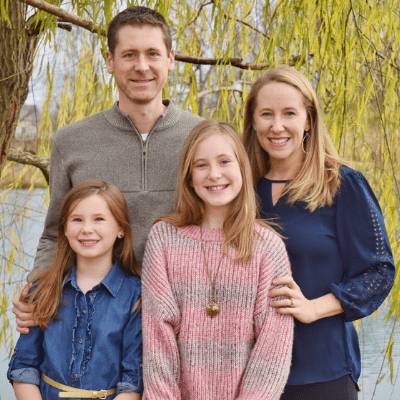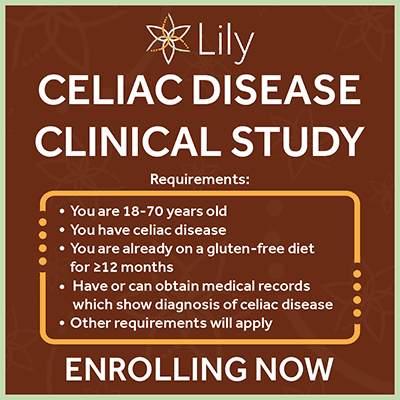“She’s an intuitive and empathetic kiddo. We’ve spoken several times about this disease and its impact on her; we’ve said, ‘If we could take this from you, we would,’ and you know what she says? ‘I don’t like this, at all, but I wouldn’t change a thing. This is part of my story. God put this in my path for a reason, so that I can help other people.’ At such a young age, she already has such a beautiful perspective and view of the silver lining.”
Meet Valerie Anderson (St. Louis, Missouri)
When Valerie Anderson’s then six-year-old daughter started losing her spark, her intuition told her something was wrong. “She’s a vibrant child, friendly and outgoing, but she stopped engaging and stopped going outside to play with her friends. She was telling us her tummy hurt constantly, and she was super low on energy.”
Determined to find the answer, the family turned to their pediatrician, but each new recommendation failed to provide relief. “We arrived at a point after a few months where we had seen no improvement in anything the doctor suggested. The doctor was saying, ‘She’s a kid, she’ll grow out of it. Tummy aches are normal.’ I pushed back and said, ‘That’s not enough.’ The doctor then recommended a blood test for celiac disease. It was like a light bulb went off and she said, ‘I think I know what this is. I’m 90% certain she has celiac disease.’”
Following off-the-charts blood results, a Valentine’s Day endoscopy confirmed celiac disease, changing the family’s life from that moment forward. “It felt very overwhelming. How do we tell a six year old no more pizza, no more cookies, no cake? And the goldfish crackers that you love—those are gone,” Valerie explains, “It’s been a journey. It started with a lot of reading and research, learning about the disease, triggers, impacts, and the critical element of cross-contact. I joined groups on social media focused on the disease and support, I started looking for institutions that were researching the disease, looking for anything, really, that could help us understand, cope and plan for the future. From that point, as a family, we made the decision that our house would be gluten-free. Especially having already known I had issues with gluten, it was a great turning point to force all four of us to get a hold on what we were putting in our bodies. The number one thing we do as a family to support our daughter and help her thrive with celiac disease is to have a gluten-free home.”
Pre-diagnosis, baking was a source of joy for Valerie and her daughters. As the family learned to navigate the gluten-free diet, they started experimenting with fun new recipes, as well as modifying old family favorites, and ultimately found renewed joy in gluten-free baking. “We found a virtual class this spring with a professional pastry chef who, through her own health journey, is gluten-free, and she brought fun and delicious recipes every week. Stuff we hadn’t worked up the nerve to try yet, like cream puffs, yeast donuts, and even gooey butter cake, which is a St. Louis tradition.”
Though raising a child with celiac disease has its own unique challenges, such as at school and birthday parties, Valerie works to ensure a safe and as normal as possible childhood for her daughter, wherever food may be. “We did, for a season, transition away from typical experiences around food because it was hard—hard to deal with the emotions, hard to explain the situation to the host, why we’re bringing our own food or why we’ve come to celebrate but not partake. Hard to always have to pack and prepare food. But we’re learning how to navigate social scenes better. We come prepared with our own snacks and substitutes. It’s just a way of life now. Pre-diagnosis, I always had snacks with me; now I have twice as many, just to be sure! We, as her parents, work hard so she can thrive and be social and not have to worry too much about the food, while also teaching her to read labels, ask questions and advocate for herself when she’s in a situation that not everyone understands.”
Beyond an understanding of the gluten-free diet and how to keep her child safe, Valerie and her family have also found a deeper understanding and appreciation for others facing invisible illnesses through her daughter’s celiac disease diagnosis. “We’ve been able to talk about why that friend is tired all the time or why someone is sad when it doesn’t seem like there’s anything wrong. It’s created an empathy in our daughters that takes many adults decades to understand.”
The opportunity to help is what drew Valerie to the Reach Beyond Celiac Ambassador Program, hoping to support others on their celiac disease journey by spreading awareness, being supportive and helping people feel less alone in this sometimes socially-isolating disease. “We’re a little more than three years into our journey, and we have a lot of experience under our belts, but also, we have joy. We’re living a good life. It looks different from the average American, but it’s ours and it’s good. I want to be able to come alongside other families, other adults, other children, other caregivers who are trying to figure out, ‘How do I eat? How do I live? How do I interact?’ and be supportive and help them not feel as alone, isolated, or overwhelmed.”
As an ambassador, Valerie looks eagerly to the future with the possibility of a cure by 2030 for her daughter. “In my heart of hearts, I’m thinking ahead to the 10-year goal that we’ve got in mind with Beyond Celiac, and thinking about our now almost ten year old going off to college and embarking on her life with celiac disease in tow. Candidly, a cure would make it a lot easier for her, enabling her to socialize and interact with the world around her and have food not be a concern,” Valerie says. “It would be a phenomenal win for her and others like her living with celiac disease.”
Donate here to support our Ambassador program.




